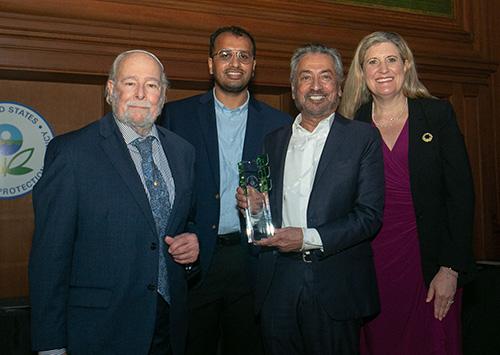
Sanjoy Banerjee, Distinguished Professor of Chemical Engineering at CCNY, holds the Green Chemistry Challenge Academic Award presented to him by the U.S. Environmental Protection Agency in Washington, D.C., for developing groundbreaking rechargeable Alkaline Zn-MnO2 Batteries. From left are: Imre Gyuk, Director Energy Storage Program, Office of Electricity, Department of Energy; Gautam Yadav, Research Associate, CUNY Energy Institute; and Alexandra Dapolito Dunn, ESQ., Assistant Administrator of the Environmental Protection Agency for Toxic Substances.
At the helm of The City College of New York’s pioneering research in the field, Sanjoy Banerjee, Distinguished Professor of Chemical Engineering in the Grove School of Engineering and Director of the CCNY-based CUNY Energy Institute, is the recipient of the U.S. Environmental Protection Agency’s 2019 Green Chemistry Challenge Academic Award for developing “rechargeable Alkaline Zn-MnO2 Batteries for Grid Storage Applications.” The Award citation also notes the important project-related partnerships with Sandia National Laboratories, Brookhaven National Laboratory, the Energy Storage Program of the Office of Electricity, Department of Energy, and Urban Electric Power, Inc.
The Green Chemistry Awards promote the environmental and economic benefits of developing and using novel green chemistry. They recognize chemical technologies that incorporate the principles of green chemistry into chemical design, manufacture, and use.
Banerjee and his partners were recognized by the EPA in Washington, D.C., for a significant breakthrough in green technology initiated at the Grove School. They developed large-scale zinc-manganese oxide batteries that can be recharged thousands of times without the typical decrease in the length of the battery’s life-time. The batteries do not have the safety and environmental limitations of lithium-ion and lead-acid batteries, and use zinc and manganese, materials that are non-toxic and abundant.
Grove School researchers key to the success of the project included Dr. Nilesh Ingale, who together with research associate Michael Nyce built the early zinc-manganese dioxide prototype batteries in 2012; Dr. Gautam Yadav, who made the breakthrough discovery of how to access the full theoretical capacity of the manganese dioxide cathode in 2015- solving a hundred-year old problem; and Dr. Jinchao Huang, who in 2017 conceived the separators that blocked the anode materials from diffusing to the cathode and degrading its performance.
The technology has now been commercialized for use in grid stabilization, renewable energy storage, and in households. The batteries are available through Urban Energy Power, Inc., a spinoff of the CUNY Energy Institute with a manufacturing plant in Pearl River, New York.
About the Grove School of Engineering
CCNY’s Grove School of Engineering celebrates a century of educating engineers this year. Originally established as the School of Technology in 1919, it evolved to the School of Engineering in 1962 and was renamed The Grove School of Engineering in 2005 in honor of alumnus Andrew S. Grove, whose $26 million gift to the institution that year is the largest in CCNY’s history. A distinguished member of CCNY’s Class of 1960, Grove was a founder and former chairman of Intel Corp, one of the world’s leading producers of semiconductor chips. Today, the Grove School remains the only public school of engineering in the heart of New York City.
About The City College of New York
Since 1847, The City College of New York has provided a high quality and affordable education to generations of New Yorkers in a wide variety of disciplines. CCNY embraces its role at the forefront of social change. It is ranked #1 by the Harvard-based Opportunity Insights out of 369 selective public colleges in the United States on the overall mobility index. This measure reflects both access and outcomes, representing the likelihood that a student at CCNY can move up two or more income quintiles. In addition, the Center for World University Rankings places CCNY in the top 1.2% of universities worldwide in terms of academic excellence. More than 16,000 students pursue undergraduate and graduate degrees in eight professional schools and divisions, driven by significant funded research, creativity and scholarship. CCNY is as diverse, dynamic and visionary as New York City itself. View CCNY Media Kit.